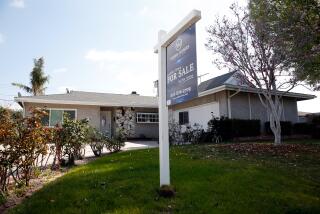High-end home sellers lower their sights
Billionaire tax cheat Leona Helmsley loved a good bargain. So, were she still around, the late hotelier might appreciate recent happenings at her Greenwich, Conn., estate known as Dunnellen Hall.
FOR THE RECORD:
Luxury-home prices: An article in Business on Saturday about a slump in the high-end housing market referred to Osterville, Maine. Osterville is in Massachusetts. —
The 14-bedroom, 13 1/2 -bathroom mansion, which came on the market priced at $125 million two years ago, has been reduced to $60 million. That’s a 52% price chop for the 21,897-square-foot Jacobean manor on 40 rolling acres. The home comes with a 52-foot indoor swimming pool, a walled courtyard featuring a 70-foot reflecting pool and a roof terrace with views of the Long Island Sound.
The Southern California real estate landscape, likewise, has been littered with its share of high-profile price drops.
Nicolas Cage’s 11,817-square-foot English Tudor in Bel-Air has been reduced 50% to $17.5 million from $35 million when it first hit the market in 2006.
Les Baux de Palm Springs, home of Suzanne Somers and Alan Hamel, started at $35 million more than two years ago and was eventually slashed to a reported $12.9 million -- a 63% reduction. The 65-acre property remains on the market with the price “available upon request.”
When the housing bubble popped, the most dramatic declines hit the mid-priced and low-end markets, where home sellers had to compete with cheap foreclosures. Now, even the wealthy are facing the new reality as some luxury homes’ prices have dropped -- and dropped again -- over the last few years and agents are begging sellers to be realistic in setting an asking price.
“The $10-million-plus market is best priced close to the bone,” said Michael Eisenberg of Keller Williams Realty, Beverly Hills.
At the peak, Eisenberg said, he had clients who were flipping every two or three years and making so much money they almost didn’t need to work anymore. These days he’s happy to take a languishing listing.
“It doesn’t hurt that the state of the market has helped sellers get a better perception as to what their property is currently worth,” he said.
Eisenberg has the listing of a home that tops 14,000 square feet with a 3,500-square-foot detached guesthouse nestled on more than an acre of land -- and an asking price that has been reduced by about half to $10.8 million. Its rooftop tennis court has city-to-ocean views, and the ballroom can hold 200 people.
“I listed it for this seller a few years ago in a different market,” said Eisenberg, who has been selling real estate for 15 years. “Quite simply, there was a time that Sunset Strip showplaces were garnering close to $2,000 a foot.”
That figure has dropped to probably $800 today, he said.
“The market moved, and so with it did the price,” Eisenberg said. “The seller is a smart businessman and a reasonable guy -- he gets it -- and the best part is that he is under no real pressure to sell as the property is owned free and clear of any debt.”
Therein lies one reason for more overpricing in the luxury home market, said Gary Painter, director of research at the USC Lusk Center for Real Estate.
“What’s different about the high end, compared to the general population, is that people who have substantial resources are able to wait longer” to sell, Painter said. “In the bottom of the market you see negative-equity situations, loans going up, people must sell. Outside forces force them to price to sell. Those sorts of outside forces aren’t as present [at the upper end].”
Because luxury homes are often one-of-a-kind and there are fewer sales in such a narrow marketplace, groups that track statistics pick varying points as the cutoff for this market. Homes priced at $2 million and above -- the dividing line at Trulia.com, a San Francisco-based website that tracks the market using Multiple Listing Service feeds -- account for most price drops nationwide. Such homes represent less than 2% of Trulia listings but are responsible for 24% of the dollar volume in asking-price reductions.
The act of repeatedly lowering the asking price until a buyer is found is known as “chasing the market,” said Michael Gardner, an agent with Prudential Malibu Realty who shares his observations on the beach city market at www.themaliburealestateblog.com. It can be a time-consuming way to sell a house.
But sellers’ thinking has been slow to adjust to the sea change in pricing since the bubble burst.
When determining an asking price, a good agent starts by evaluating the prices of comparable recent sales in the area rather than looking at the prices of active listings, Gardner said. “They then take the numbers to the client, where they may have to battle the client’s ego.”
A frequent refrain of the seller, he said, is “My house is better than that one.”
Some agents, fearing they won’t get the listing, will go with the higher price the client wants, Gardner said. In this case, he recommends the agent include a caveat: “I’ll list it at your price, but if we don’t have any offers in 30 days I’ll be asking for a price reduction.”
These types of sellers, he said, “want to test the water.”
But this is a trickier proposition in a market in which values are falling, said Darryl Davis, a real estate agent in Wading River, N.Y., who trains agents across the nation. “You need to price ahead of the market instead of lowering the price every 30 days,” he said.
It’s one thing for an agent to take an overpriced listing when prices are rising. “It’s possible the market will catch up with the price eventually,” Davis said. “But the reverse is happening. To take an overpriced listing now is pointless for the agent and the homeowner.”
Jack Cotton Jr., who specializes in the Cape Cod luxury market at Sotheby’s International Realty in Osterville, Maine, says no to sellers who won’t price realistically. He turned down the listing of an 11-acre property overlooking the water that the seller wanted to price at $4 million.
“Now it’s bank-owned and it’s still not selling,” Cotton said. The current asking price is $1.8 million.
This is not to say that homes with stratospheric asking prices don’t eventually sell after they’ve had time to come down to earth. A newly built home on more than two acres in Malibu’s Paradise Cove area sold last year for $17.5 million -- 56% off its original $39.5-million asking price less than a year earlier. Terra Bella, an Italianate home of nearly 14,000 square feet on three oceanfront acres in Santa Barbara’s Hope Ranch, sold in the fall after first coming on the market at $39.5 million in May 2007. Based on transfer tax information from the Santa Barbara county clerk’s office, the property sold in October for $12.8 million, more than 67% off the original asking price.
Last year there were 332 sales of homes for $5 million or more statewide, according to MDA DataQuick, a dramatic drop from 608 such sales in 2008 and 565 in 2007.
More so perhaps than in other parts of the nation, Southland sellers have another reason for overpricing at the onset: the magical belief that a star will happen upon their place and be willing to pay any price.
“The story of celebrities knocking on doors and overpaying for a house they ‘have to have’ still floats around,” Malibu agent Gardner said.
Reinforcing the popular myth, Cotton said, is that “every once in a while the real estate god looks down and someone will buy a place that’s overpriced.”
More to Read
Inside the business of entertainment
The Wide Shot brings you news, analysis and insights on everything from streaming wars to production — and what it all means for the future.
You may occasionally receive promotional content from the Los Angeles Times.











